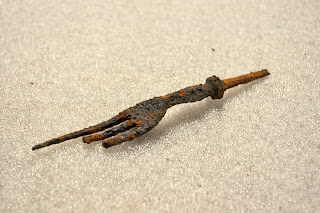Here is a step by step walk through of the Archaeology Project:
First, I start with a bag containing all of the artifacts recovered in a lot:
Next, I take out everything out of the bag:
 |
| The bags usually are grouped by type of item |
Then, I
line each artifact up in lines of five, so that I can keep a count of how many tags to make and make sure that I don't misplace the extra small pieces:
 |
| Insert Rain Man joke here |
Using the master tag from the lot, I copy the information onto each new tag:
Once those are done, I generate catalog numbers for each item based on the year they were excavated, 1995, the lot they are in, and the individual item's new number in the lot:
 |
| So this piece will be item 4, in lot 176 |
After the tags are finished, I start putting the tag (catalog number facing out), and item in the appropriately sized bag:
 |
| Almost done! |
After everything is tagged and bagged, I put all of the individual baggies from the lot into a larger bag so that Kevin can enter them into the database.
Here is me hard at work!
Some of the items, like the bandaid, seem like they are not very worthwhile to bag. The lots that I worked on today had a ton of rocks in them. Kevin tells me that these rocks are important because they have a bit of mortal on them and were probably early foundations of Gibbs dwellings. I guess anything modified by humans was removed from the site.
 |
| This looks a lot like a normal rock collection |
 |
| There's some history on this rock |
Today, I worked on this project for eight hours and managed to get about 19 lots finished. The most common things I came across today were rocks, shards of glass and lots of burnt wood. So many pieces of burnt wood! The problem with the wood is that when the excavator initially bags them, there may be one or two pieces, however, after having been stored for twelve years, the fragile carbon has broken apart into dozens of small fragments. Each one of them needs it's own bag and tag, and the wood accounts for most of the work I end up doing. Like the balloon, I'm not quite sure why each small piece needs to be saved, but I'm sure that in the future the wood will be analyzed and be able to tell researchers important things about the way the Gibbs lived. I'm not quite sure what the important things are, but I'll ask Kevin next week and report back with his answer. My guess is that the wood is able to tell historians what types of trees were in the area and where the family did it's cooking, and therefore, its living. We'll see though.
Next Monday is going to be very exciting because we are all going to tour the Science Museum of Minnesota's collections and I am really looking forward to being able to talk to the curator about the various temporary exhibits and the things the museum does. My ultra dream goal of the trip is to see some old 19th century medical and science equipment. That would be super super cool!!!!!!!





































